Xử lý tín hiệu số Sampling and Reconstruction
Ngô Quốc Cường ngoquoccuong175@gmail.com Ngô Quốc Cường sites.google.com/a/hcmute.edu.vn/ngoquoccuong
Sampling and reconstruction
Introduction
2
• • Review of analog signal • Sampling theorem • Analog reconstruction
1.1 Introduction
3
Digital processing of analog signals proceeds in three stages: 1. The analog signal is digitized, that is, it is sampled and each sample quantized to a finite number of bits. This process is called A/D conversion. 2. The digitized samples are processed by a digital signal processor. 3. The resulting output samples may be converted back into analog form by an analog reconstructor (D/A conversion).
1.2 Review of analog signal
• An analog signal is described by a function of time, say, x(t). The Fourier transform X(Ω) of x(t) is the frequency spectrum of the signal:
• The physical meaning of X(Ω) is brought out by the inverse
4
Fourier transform, which expresses the arbitrary signal x(t) as a linear superposition of sinusoids of different frequencies:
1.2 Review of analog signal
• The response of a linear system to an input signal x(t):
• The system is characterized completely by the impulse
5
response function h(t). The output y(t) is obtained in the time domain by convolution:
1.2 Review of analog signal
•
In the frequency domain by multiplication:
as the Fourier transform of the impulse response h(t):
6
• where H(Ω) is the frequency response of the system, defined
1.2 Review of analog signal
7
CT Fourier Transforms of Periodic Signals
Source: Jacob White
8
Fourier Transform of Cosine
Source: Jacob White
9
Impulse Train (Sampling Function)
Note: (period in t) T (period in ) 2/T
Source: Jacob White
10
1.3 Sampling theorem
• The sampling process is illustrated in Fig. 1.3.1, where the
11
analog signal x(t) is periodically measured every T seconds. Thus, time is discretized in units of the sampling interval T:
1.3 Sampling theorem
• For system design purposes, two questions must be
answered:
12
1. What is the effect of sampling on the original frequency spectrum? 2. How should one choose the sampling interval T?
1.3 Sampling theorem
• Although the sampling process generates high frequency components, these components appear in a very regular fashion, that is, every frequency component of the original signal is periodically replicated over the entire frequency axis, with period given by the sampling rate:
13
• Let x(t) = xc(t), sampling pulse s(t)
1.3 Sampling theorem
Source: Zheng-Hua Tan
14
1.3 Sampling theorem
Source: Zheng-Hua Tan
15
1.3 Sampling theorem
Source: Zheng-Hua Tan
16
1.3 Sampling theorem
Source: Zheng-Hua Tan
17
1.3 Sampling theorem
Source: Zheng-Hua Tan 18
1.3 Sampling theorem
Source: Zheng-Hua Tan 19
1.3 Sampling theorem
• The sampling theorem provides a quantitative answer to the
question of how to choose the sampling time interval T. • T must be small enough so that signal variations that occur
•
20
between samples are not lost. But how small is small enough? It would be very impractical to choose T too small because then there would be too many samples to be processed.
1.3 Sampling theorem
Hardware limits •
•
In real-time applications, each input sample must be acquired, quantized, and processed by the DSP, and the output sample converted back into analog format. Many of these operations can be pipelined to reduce the total processing time. In any case, there is a total processing or computation time, say Tproc seconds, required for each sample.
21
where:
1.4 Aliasing and reconstructor
• The set of frequencies,
22
are equivalent to each other. • Among the frequencies in the replicated set, there is a unique one that lies within the Nyquist interval. It is obtained by reducing the original f modulo-fs.
1.4 Aliasing and reconstructor
23
• Antialiasing prefilters
1.4 Aliasing and reconstructor
24
• An ideal analog reconstructor extracts from a sampled signal all the frequency components that lie within the Nyquist interval.
Exercises 1
25
• Let x(t) be the sum of sinusoidal signals
Exercises 2a
• A sound wave has the form
26
where t is in milliseconds. What is the frequency content of this signal? Which parts of it are audible and why?
Exercises 2b
27





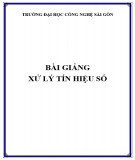
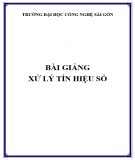
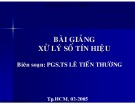
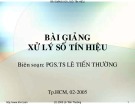
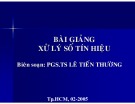
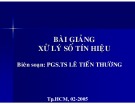





![Đề thi cuối học kì 2 môn Cấu trúc dữ liệu và giải thuật [kèm đáp án/mới nhất]](https://cdn.tailieu.vn/images/document/thumbnail/2025/20251014/lakim0906/135x160/89711760416179.jpg)


![Tài liệu Nhập môn Học máy và Khai phá Dữ liệu [chuẩn nhất]](https://cdn.tailieu.vn/images/document/thumbnail/2025/20251001/kimphuong1001/135x160/531759303870.jpg)






